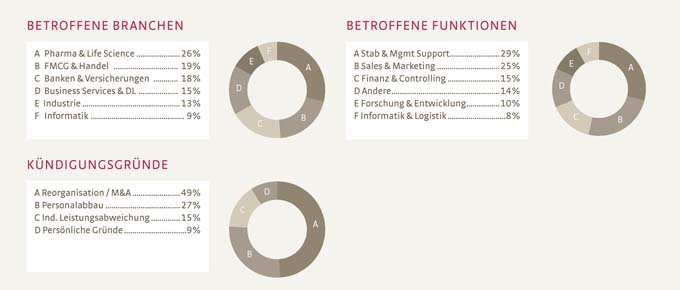Normalization of the labor market - grace period for over 50s over?
The outplacement company von Rundstedt has analyzed labor market data from all of last year 2022 and provided new statistics. As in 2021, the year 2022 was dominated by economic growth according to Corona. This has further exacerbated the shortage of skilled workers and made it more acute in individual sectors. What specific impact did this have on the labor market and the situation of job seekers in Switzerland?

Von Rundstedt's Labor Market Barometer 2023 covers the whole of Switzerland and is based on information from 1,866 employees affected by a dismissal and from 192 companies from various sectors that had to make redundancies in Switzerland in 2022. It thus provides a representative picture of the Swiss labor market as a whole in 2022, from which a number of interesting findings can be derived.
Economic and labor market slowdown imminent
"Since mid-2022, more layoffs have been announced again and first downsizing projects and restructurings have been announced. There will be more layoffs again in the near future," says Pascal Scheiwiller, CEO of Von Rundstedt. After significantly fewer layoffs were announced in 2021 and the first half of 2022, an increase in layoffs has been noticeable again since mid-2022. Given the large number of vacancies, this is not as significant. On the other hand, there is again more fluctuation and the conditions on the labor market seem to be slowly returning to normal, according to the outplacement specialist. Reference is also made to the observation that at the end of 2022, more downsizing and restructuring projects had again been announced. In total, 76% of the terminations in 2022 would have taken place against the background of a downsizing or restructuring measure. This compares with only 67% in the previous year. This indicates that companies are again making more structural adjustments and are not only looking for new staff, but are also releasing staff and adjusting the organization at the same time. This does not yet point to a recession, but to a kind of normalization of the labor market.

No more moral protection for Ü50
It seems that before the current labor market situation, the "grace period" for older employees has expired. Pascal Schweiller: "Currently, the dismissal rate for the over-50s is significantly higher than for the other age groups. The many vacancies apparently legitimize companies to increasingly dismiss older employees without activating special protective measures." The figures prove: in 2022, 39% of the terminations affected the Ü50 age group. This rate is significantly higher than the previous year (31%) and the Ü50 employment rate of 32%. In recent years, it has mostly been close to the employment rate (30-32%). So in 2022, relatively speaking, many more Ü50 have been laid off. Apparently, the good market environment for job seekers and the many vacancies mean that employers are no longer very worried about those affected, nor are they afraid of negative press and reputational damage in the event of Ü50 terminations.
More difficult profiles also find a new job more quickly again
But still, the situation for job seekers cannot be described as dramatic. "The duration of the job search has decreased once again. Especially for people over 50 and for difficult profiles, the search duration has significantly shortened," says Pascal Scheiwiller. The average job search duration across all categories was 5.2 months in 2022, down from 5.3 months in 2021. However, the situation has improved significantly, especially in the over-50 category. Within two years, it has fallen from 8.3 months (2020) to 6.9 months (2021) and now 6.1 months (2022) - a positive development. In general, the range between supposedly easy and difficult profiles has become smaller. In 2020, the average search duration for difficult profiles was still 11.8 months. In 2021, the search duration of this category has already been reduced to 9.2 months and in 2022 to 7.3 months. Thus, according to von Rundstedt, all categories are currently benefiting from the shortage of skilled workers and are finding a new job much faster.
Good opportunities with publicly advertised positions
In recent years, the hidden job market and personal networks have long been the secret recipe for success in getting the really exciting jobs. This has become somewhat relative over the past year, according to another of Von Rundstedt's findings. In 2022, only 27% of job seekers found their jobs through the personal network (2021: 37%). Most new jobs in 2022 were found through public job postings (48%). This success rate is significantly higher than the previous year (34%). This is due to the fact that more and more jobs are also advertised publicly. The selection of advertised jobs is currently very large. Recruiters and headhunters are becoming relatively less important. They can look back on two good business years due to the recruitment wave of the last two years. Nevertheless, their relative importance is declining. In 2022, only 3% of job seekers found their new job through a recruiter. This is a large decrease compared to previous years (2021: 9%).
Continued high industry mobility
Another finding is that although many companies still stick to industry experience in recruiting, the willingness to hire candidates from outside the industry has increased sharply over the past two years. In 2022, 48% of job seekers were able to make a successful industry switch. This is a testament to the increasing flexibility of employers and once again highlights the pressures of the skills shortage. Much less mobility is observed in the function of a job seeker. In 2022, only 24% of candidates were able to change function. Especially with regard to the Digital Transformation and the upcoming structural changes, a higher functional mobility would be desirable. If at all possible, companies only hire candidates who already have experience in the same function.
Salary development stable and positive
"Thanks to the shortage of skilled workers and inflation, salaries are tending to rise. Nevertheless, the development seems quite stable compared to other countries," says Pascal Scheiwiller about the development of wages. In 2022, 40% of job seekers would have been able to achieve a higher salary in their new position after being laid off, the analysis of the data shows. Only 21% had to accept a lower salary. Indexed, this results in an average salary increase of 2% in this category. Thus, the development is in line with inflation and can be considered stable. It should be noted that companies are happy to wave good salaries in the case of critical profiles and direct poaching. The salary development for this category is 13%. This confirms the thesis that the shortage of skilled workers in specific areas is clearly boosting salary development.
Source: Von Rundstedt









